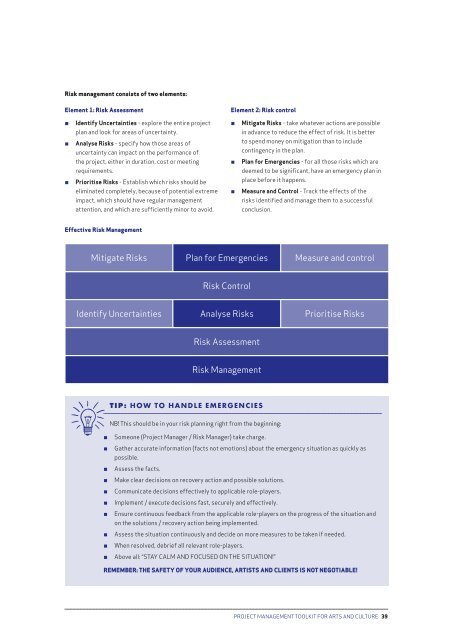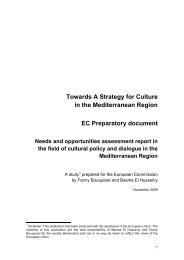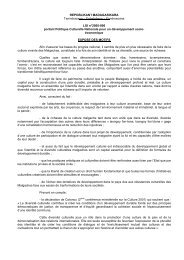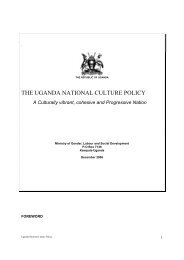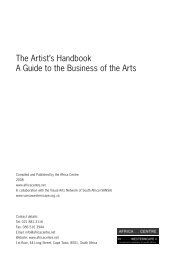Project Management Toolkit - Arts In Africa
Project Management Toolkit - Arts In Africa
Project Management Toolkit - Arts In Africa
You also want an ePaper? Increase the reach of your titles
YUMPU automatically turns print PDFs into web optimized ePapers that Google loves.
Risk management consists of two elements:<br />
Element 1: Risk Assessment<br />
¬ Identify Uncertainties - explore the entire project<br />
plan and look for areas of uncertainty.<br />
¬ Analyse Risks - specify how those areas of<br />
uncertainty can impact on the performance of<br />
the project, either in duration, cost or meeting<br />
requirements.<br />
¬ Prioritise Risks - Establish which risks should be<br />
eliminated completely, because of potential extreme<br />
impact, which should have regular management<br />
attention, and which are sufficiently minor to avoid.<br />
Effective Risk <strong>Management</strong><br />
Mitigate Risks<br />
Identify Uncertainties<br />
¬<br />
¬<br />
¬<br />
¬<br />
¬<br />
¬<br />
¬<br />
¬<br />
¬<br />
¬<br />
Element 2: Risk control<br />
Plan for Emergencies<br />
Risk Control<br />
Analyse Risks<br />
Risk Assessment<br />
Risk <strong>Management</strong><br />
Tip: how to handle emergenCies<br />
NB! This should be in your risk planning right from the beginning:<br />
Someone (<strong>Project</strong> Manager / Risk Manager) take charge.<br />
¬ Mitigate Risks - take whatever actions are possible<br />
in advance to reduce the effect of risk. It is better<br />
to spend money on mitigation than to include<br />
contingency in the plan.<br />
¬ Plan for Emergencies - for all those risks which are<br />
deemed to be significant, have an emergency plan in<br />
place before it happens.<br />
¬ Measure and Control - Track the effects of the<br />
risks identified and manage them to a successful<br />
conclusion.<br />
Measure and control<br />
Prioritise Risks<br />
Gather accurate information (facts not emotions) about the emergency situation as quickly as<br />
possible.<br />
Assess the facts.<br />
Make clear decisions on recovery action and possible solutions.<br />
Communicate decisions effectively to applicable role-players.<br />
Implement / execute decisions fast, securely and effectively.<br />
Ensure continuous feedback from the applicable role-players on the progress of the situation and<br />
on the solutions / recovery action being implemented.<br />
Assess the situation continuously and decide on more measures to be taken if needed.<br />
When resolved, debrief all relevant role-players.<br />
Above all: “STAY CALM AND FOCUSED ON THE SITUATION!”<br />
REMEMBER: THE SAFETY OF YOUR AUDIENCE, ARTISTS AND CLIENTS IS NOT NEGOTIABLE!<br />
PROJECT MANAGEMENT TOOLKIT FOR ARTS AND CULTURE 39


